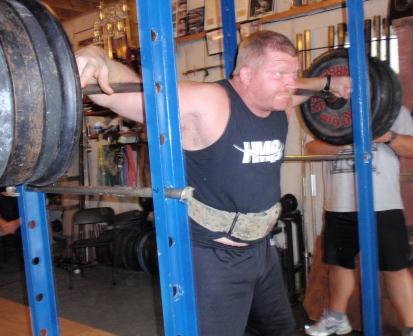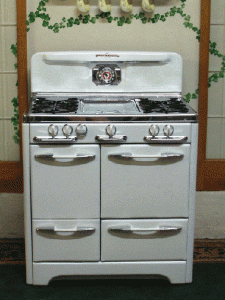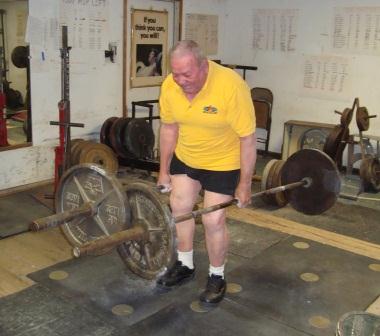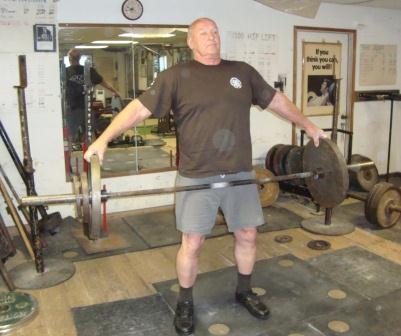Battle in the Barn
by Eric Todd
MEET ANNOUNCEMENT – BATTLE IN THE BARN
Sunday, March, 25 2012 will be the inaugural “Battle in the Barn” which will be the third USAWA Old Time Strongman event.

Eric Todd will be the meet director for the "Battle in the Barn", the third Old Time Strongman Competition promoted by the USAWA.
Where: ET’s House of Iron and Stone-The KCSTRONGMAN headquarters near Cameron, MO
When: March 25 at 10:00 AM
Weigh ins: 9:00 AM
Entry Cost: $20
Entry Deadline : Entries must be in hand by Sat, March 17, 2012
Divisions: Lightweight (under 200#), Middleweight (200-250#), Heavyweight (Over 250#), Masters (over 40)
Awards: Awards for top 3 per division. Best lifter award.
Events: Appollons Lift, Crucifix, Partial Deadlift, and Goerner Stroll
Rules of the Lifts
Apollon’s Lift – A 2 inch diameter axle (or Fulton Bar) will be used as the bar for this lift. The maximum starting bar height is 12 inches measured from the platform to the bottom of the bar. Any method may be used to take the bar to the shoulders or overhead. The bar or plates are allowed to retouch the platform during the lift. If the bar is placed down or dropped, the lifter may try again as many times as he/she wants within the time limit. A time limit of 1 minute is allowed. Once the weight is overhead, with arms’ locked, legs straight, and the feet in line with the torso, an official will give the command to end the lift.
Crucifix (standard USAWA Rules) – Two evenly loaded dumbbells or kettlebells are used for this lift. The lift begins at the lifter’s discretion. The dumbbells are taken to arms’ length overhead with the palms of the hands facing each other and dumbbells touching. The lifter must bring the feet together so the heels are together and touching. The body must be upright at the start of the lift. Once in this position, an official will give the command to start the lift. The lifter will then lower the dumbbells to the side with arms’ straight and palms up. Elbows must be fully locked. The lifter may lean back to any extent when lowering the dumbbells. The wrists do not need to be held straight. The legs must remain straight and knees locked throughout the lift. The heels must remain together and the heels and toes must not rise during the lift. Once the arms are parallel to the platform, and the dumbbells motionless, an official will give a command to end the lift.
Partial Deadlift – This is a partial deadlift, where the bar height must not be over 18″ from the platform. The plates or bar may be supported on stands or blocks to obtain this height. The lifter must have the bar in front of the legs, as in a normal deadlift. Lifting straps or any other gripping aid is not allowed. It is NOT an infraction to drag the bar up the legs, bounce the bar up the legs, or support the bar on the legs during the lift (hitching). A one minute time limit is allowed for the lifter to make a legal lift, during which time a lifter may make multiple tries. Once the lifter is totally upright and the bar motionless, an official will give the command to end the lift.
Goerner Stroll– Two barbells will be used. The lifter must pick up both barbells at the same time, one in each hand, and walk (or run) a distance of 1 rod (or 16.5 feet). The starting and finish lines must be marked. The plates on the bars must be behind the starting line at the start, and finish entirely beyond the finish line at the end. The weight selected on the bars must not be changed during the attempt. Both bars must be loaded to the same weight. A one minute time limit is allowed for the attempt. If the bars are set down or dropped between the starting and finish lines during this 1 minute time limit, the lifter may start over, but MUST restart at the starting line. Strapping the bars to the hands is NOT ALLOWED.
All other general rules of the USAWA will apply. Scoring will be done according to the USAWA guidelines. Each competitor will get three attempts of their choosing with the best one counting towards their total.
Entry Form – Battle_in_the_Barn_entry
Any Questions, please ask on the forum, or email me at SalGuimino@yahoo.com.


